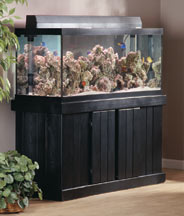
Bringing an aquarium into your home or office is a great way to add vibrant color and life to your interior, as well as learn more about part of the natural world often hidden from our everyday lives. Caring for a freshwater or marine tank is both challenging and rewarding, but you can increase your chances of success by simply doing some research up front. If you're considering investing in an aquarium setup, it's important to consider some questions before taking on the responsibilities of this fun and exciting hobby:
- What types of fish, invertebrates, coral and/or Reef Rock do you want to get, and will they be a compatible mix with each other? To compare which aquatic life is generally compatible, please visit our
Species Compatibility Chart.
- What size and shape of aquarium is appropriate for the species mix you envision?
- What types of filtration, lighting, decorative structure, and accessory equipment are needed in order for the aquarium inhabitants to thrive?
- What feeding and maintenance is required to keep them healthy?
- Most importantly, are you willing to invest the time and money necessary for ongoing maintenance?
Rules of thumb
 In order to answer some of the questions raised above, it's good to know some "aquarium basics." Here are some rules of thumb to consider when you are setting up your aquarium and helpful tips for setting up your first tank:
In order to answer some of the questions raised above, it's good to know some "aquarium basics." Here are some rules of thumb to consider when you are setting up your aquarium and helpful tips for setting up your first tank:
- Generally, the larger the aquarium the better, unless it will be too heavy for the flooring to hold it. A tank that is filled with gravel and water will weigh at least 10 lbs. per gallon. That adds up quickly, if you consider that a seemingly small 20-gallon tank will weigh 200 pounds . . . and that does not account for the stand, lighting, or filtration!
- It is imperative to choose a sturdy stand to hold the tank. If you choose to set up your tank in an environment frequented by small children, choose a stand that cannot be climbed on or pulled over.
- Choose a filter appropriate to the type of inhabitants you are keeping and water capacity of the tank. Buy the best filter that you can afford. At minimum, a filter should provide mechanical and biological filtration. To learn more about filtration systems,
click here.
- Next you'll need a heater and a good thermometer. Make sure the heater is at least 3-5 watts per gallon. For example, a 50-gallon tank would require a 150-250 watt heater.
- You will need to choose an aquarium cover or hood. If the inhabitants require special lighting, you'll want to purchase a fixture that can accommodate it.
- A water conditioner will be needed to remove chlorine and heavy metals if they are present in your water supply.
- Don't forget a net!
- Now you're ready to decorate. It's essential to choose decorations that provide fish with structure and hiding places to relieve stress. Plants and decorations can also be used to conceal filter parts. Gravel in the bottom of the tank holds plants and decorations while hiding wastes. If you will be using an undergravel filter, the gravel should be about 2 inches thick. Dark colors will make the fish color appear more vibrant.
- A gravel cleaner and algae cleaner will be needed within 30 days so you can begin regular maintenance.
- Before you place the items in the tank, rinse them off and rinse gravel thoroughly until water drained off is clear.
- Choose a sturdy, level area to set up the tank.
- Set up the stand and then the tank. Pour in cleaned gravel.
- Fill the tank with water about 3/4 full, then put in decorations, set up filtration, heater, and thermometer. Continue filling aquarium to 1/2" from bottom of rim. This allows extra space for when you put your first batch of fish in to acclimate.
- Now, you're ready to start up filtration, heater, and add any water conditioners needed including our Live Nitrifying Bacteria to quickly establish biological filtration. Assemble lighting/cover. Then wait until tank heater has adjusted the water to the correct temperature (75°F for most fish) and maintains it.
- Finally, you can purchase your fish and acclimate them to their new home; remember not to put too many in at one time. LiveAquaria.com also offers a detailed Acclimation Guide to make this important step easier.
You have now successfully set up your tank. Please take some time to browse both LiveAquaria.com and
PetEducation.com to discover other information, tips, and techniques for keeping fish.
|




